21 Jul 11 - this page is part of our archive. View our latest results
Introduction
The global fit to electroweak precision data routinely performed by the
LEP electroweak working group and others, demonstrates impressively the predictive
power of electroweak unification and quantum loop corrections. We have performed the fit using the most recent experimental measurements and state-of-the-art SM predictions.
Note: Parts of the results/plots presented on this page are published in (arXiv:1107.0975 [hep-ph]). They contain follwing updates:
Theoretical predictions
For the following results the Gfitter plug-in library /gsm (
download,
authors+license) has been used. It provides implementations of the latest theoretical predictions of electroweak observables. In particular:
- The mass of the W boson (MW) is calculated with the full two-loop corrections and known beyond-two-loop corrections from
(M. Awramik et al., Phys. Rev. D69, 053006 (2004), hep-ph/0311148).
- The effective weak mixing angle (sin2θeffl) is calculated with the full two-loop corrections and known beyond-two-loop corrections from
(M. Awramik et al., JHEP 11, 048 (2006), hep-ph/0608099)
(M. Awramik et al., Nucl.Phys.B813:174-187 (2009), arXiv:0811.1364).
-
The calculations of the partial and total widths of the Z and of the total width
of the W boson have been integrated from the ZFITTER package [D. Bardin et al, CPC 133 (2001) 229-395,
A.B. Arbuzov et al, CPC 174 (2006) 728-758] and are co-authored
by both groups (see authors+license). It includes up to two-loop electroweak corrections and all
known QCD corrections.
- The calculation of the massless QCD Adler function includes fourth-order (3NLO)
perturbative results [P. A. Baikov et al., Phys. Rev. Lett. 101 (2008) 012002, arXiv:0709.1983].
The free fit parameters in the Gfitter global electroweak Standard Model fit are:
- MZ : the mass of the Z boson
- MH : the mass of the Higgs boson
- Δαhad(MZ2) : the five-quark hadronic contribution to the running QED coupling constant
- αS(MZ2) : the strong coupling constant
- mt : the mass of the top quark
- mc and mb : the running MS-bar masses of the c and b quarks
- 4 parameters to account for theoretical errors for MW, sin2&thetatheta;effl and the two electroweak form factors.
Experimental input and fit results for the current global fit
In the following tables and figures the experimental input used in the fit and the fit results are given.
All fits discussed here minimise the test statistics χ
2 which accounts for the deviations
between the observables given in the table below and their SM predictions (including correlations).
Out of the ensemble of the model parameters the following are free
to vary in the fit: M
Z, M
H, m
c, m
b,
m
t, Δα
had(M
Z2),
α
s(M
Z2) and four theoretical error parameters, accounting
for theoretical uncertainties.
We perform the global electroweak fits in two versions:
- the standard (``blue-band'') fit, which includes all the observables listed
in the Table below, except for results from the direct Higgs searches.
- the complete fit includes also the results from the direct searches for the Higgs boson at LEP, Tevatron, and LHC.
The
standard (
complete)
fit converges at the global minimum value
χ
2min =0.00
(χ
2min =0.00
) for 13 (14) degrees of freedom,
giving the naive p-value Prob(χ
2min,13)=1.00
[Prob(χ
2min,14)=1.00
]. See the Section
Probing the SM for a more accurate
toy-MC-based determination of the p-value. The results after convergence of the two
fits are given in the following tables and figures.
| Table: Input values and fit results for parameters of the global electroweak fit. The first and second columns
list respectively the observables/parameters used in the fit, and their experimental
values or theoretical estimates. The subscript ``theo'' labels theoretical error ranges.
The third column indicates whether a parameter is floating in the fit.
The fourth (fifth) column quotes the results of the standard ( complete) fit
not including (including) the constraints from the direct Higgs searches at LEP and
Tevatron in the fit.
The last column gives the fit results for each parameter without using the corresponding
experimental constraint in the fit (indirect determination).
|
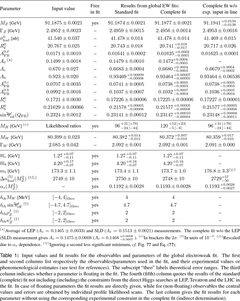 .eps
.eps
|
|
Comparing fit results with direct measurements: pull values for the
complete fit (left) and results for MH from the standard fit
excluding the respective measurements (right).
|
 .eps
.eps
 .eps
.eps
|
| Determination of MH excluding all the sensitive observables from the standard fit,
except for the one given.
|
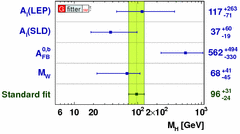 .eps
.eps
|
| Δχ2 as a function of MH for the standard fit.
The solid (dashed) line gives the results when including (ignoring)
theoretical errors.
|
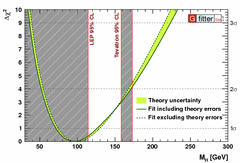 .eps
.eps
|
| Δχ2 as a function of MH for the complete fit. The solid (dashed) lines give the results when including (ignoring) theoretical errors.
|
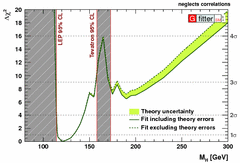 .eps
.eps
|
| Δχ2 as a function of MH for the complete fit. The solid green line represents the result for the 2-sided CL interpretation of the direct Higgs searches, while the blue dashed curve shows the result of the direct inclusion of the log-likelihood ratio provided by the experiments.
|
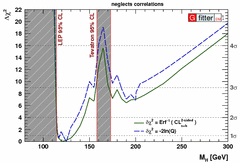 .eps
.eps
|
| The (1-CL) function derived from the Δχ2 estimator versus the MH hypothesis.
Compared are
the Gaussian approximation Prob(Δχ2,1) for the standard fit with
(dashed/red line) and without theoretical errors (solid/black line), respectively, to an
evaluation based on toy MC simulation for which theoretical errors have been ignored.
Also given is the result using Prob(.) for the complete fit (dotted/blue
line).
|
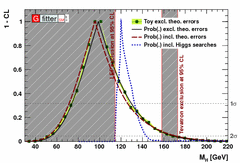 .eps
.eps
|
| Δχ2 as a function of MH with an alternative treatment of theory
uncertainties. Shown are the results of a standard fit
ignoring theoretical uncertainties (solid line), the regions determined from the maximum
deviation in Δχ2 achieved by shifting the SM predictions of all observables
according to one standard deviation of the various theory uncertainties (shaded band)
and for comparison the result of the standard fit (dashed curve) in which
theoretical uncertainties are included in the χ2 calculation.
|
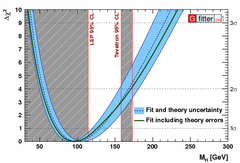 .eps
.eps
|
| Δχ2 versus mt for the complete fit (solid line) and the
standard fit (dashed), both excluding the mt determinations
indicating by the dots with 1σ error bars. Also shown the result for hypthetical Higgs
discovery at 120 GeV.
|
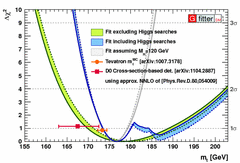 .eps
.eps
|
| Δχ2 versus MW for the complete fit (solid line) and the
standard fit (dashed), both excluding the MW world average
indicating by the dot with 1σ error bars. Also shown the result for hypthetical Higgs
discovery at 120 GeV.
|
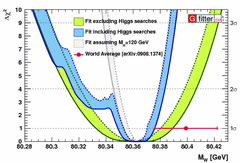 .eps
.eps
|
| Δχ2 versus the effective weak mixing for the complete fit (solid line) and the
standard fit (dashed), both excluding all precision observables sensitive to sin2&thetatheta;eff.
The dot with 1σ error bars indicates the LEP/SLD averagee. Also shown the result for hypthetical Higgs
discovery at 120 GeV.
|
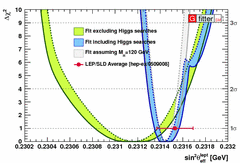 .eps
.eps
|
| Contours of 68%, 95% and 99% CL obtained from scans of fits with fixed
variable pairs mt vs. MH .
The largest/blue (narrower/purple) allowed regions are the results of the standard fit
excluding (including) the measurements of mt.
The narrowest/green areas indicate the constraints obtained for the complete fit
including all the available data. The horizontal bands indicate the 1σ
regions of the current world avergage of mt measurements.
|
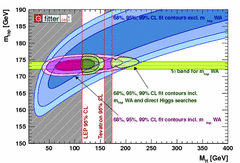 .eps
.eps
|
| Contours of 68%, 95% and 99% CL obtained from scans of fits with fixed
variable pairs Δαhad(MZ2) vs. MH.
The largest/blue (narrower/purple) allowed regions are the results of the standard fit
excluding (including) the measurements of Δαhad(MZ2).
The narrowest/green areas indicate the constraints obtained for the complete fit
including all the available data. The horizontal bands indicate the 1σ
regions of the Δαhad(MZ2) phenomenological
determination.
|
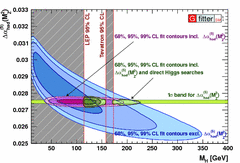 .eps
.eps
|
| Contours of 68%, 95% and 99% CL obtained from scans of fits with fixed
variable pairs MW vs. mt. The largest/blue (narrower/yellow) allowed regions
are the results of the standard fit excluding (including) the direct Higgs searches at LEP
and Tevatron. The grey shaded array shows the prediction of the masses as a function of the Higgs
mass. The horizontal bands indicate the 1σ regions of measurements (world averages).
|
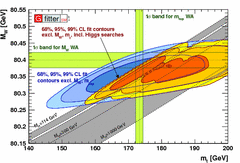 .eps
.eps
|

Probing the Standard Model
We evaluate the p-value of the global SM fit using a toy MC simulation
with 10000 experiments, These are
generated using as true values for the SM parameters the outcomes of the global fit.
For each toy simulation, the central values of all of the observables used in the fit
are generated according to Gaussian distributions around their expected SM values
(given the parameter settings) with standard deviations equal to the full experimental
errors taking into account all correlations.
Fair agreement is observed between the empirical toy MC distribution and the
χ
2 function expected for Gaussian observables.
| Result of the MC toy analysis of the complete fit. Shown are the χ2min
distribution of a toy MC simulation (open histogram), the corresponding distribution
for a complete fit ignoring theoretical errors (shaded/green histogram),
an ideal χ2 distribution assuming a Gaussian case with ndof=14 (black line)
and the p-value as a function of the χ2min of the global fit.
|
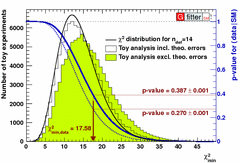 .eps
.eps
|
| P-value of the electroweak fit versus MH as obtained from toy MC simulation.
The error band represents the statistical error from the MC sampling.
|
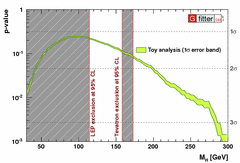 .eps
.eps
|

Prospects for the LHC and ILC
The next generation of particle colliders, namely LHC and ILC, have the potential to
significantly increase the current precision of most of the electroweak observables that are
relevant for the fit. This will improve the predictive power of the fit, and -- in case of a Higgs
discovery -- its sensitivity to physics beyond the SM by directly confronting theory and experiment,
and by testing the overall goodness-of-fit of the SM. At the time when the new measurements from the LHC experiments, and later the ILC, become available, an improved determination of Δα
had(M
Z2) will be
needed to fully exploit the new precision data. This in turn requires a
significant improvement in the quality of the experimental data on the total
hadronic cross sections at energies around the c
c resonances and below,and a better knowledge of the c and b quark masses.
We studied the prospects of the global electroweak fit using the improved measurements expected from
the LHC, the ILC with and without the option to run at the Z resonance and along the W-pair production
threshold (
GigaZ) using (i) the current precision of Δα
had(M
Z2) and
(ii) assuming an improvement (σ(Δα
had(M
Z2))=7⋅10
-5) following
(F. Jegerlehner, hep-ph/0105283).
| Table: Measurement prospects at future accelerators for key observables used in the electroweak
fit, and the resulting fit errors obtained for MH and αs(MZ2).
The estimated improvement for Δαhad(MZ2) (given in
parenthesis of the corresponding line) over the current uncertainty is unrelated to these
accelerators, and must come from new low-energy hadronic cross section measurements and
a more accurate theory. The lower rows give the results obtained for MH and
αs(MZ2). For MH are also given the results with improved Δαhad(MZ2) precision
(parantheses), and with improved Δαhad(MZ2) and in addition without theoretical
uncertainties [brackets]. A possible improvement in Δαhad(MZ2) has no effect on
the precision of αs(MZ2).
|
 .eps
.eps
|
| Constraints on MH obtained for the four future scenarios,
using σ(Δαhad(MZ2))=7⋅10-5.
From wider to narrower Δχ2 parabolas are shown with their theoretical
error bands: present constraint, LHC expectation, ILC expectations with and
without GigaZ option.
|
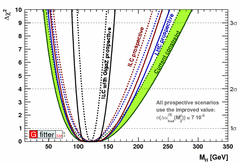 .eps
.eps
|

 .eps
.eps
 .eps
.eps
 .eps
.eps
 .eps
.eps
 .eps
.eps
 .eps
.eps
 .eps
.eps
 .eps
.eps
 .eps
.eps
 .eps
.eps
 .eps
.eps
 .eps
.eps
 .eps
.eps
 .eps
.eps
 .eps
.eps

 .eps
.eps
 .eps
.eps

 .eps
.eps
 .eps
.eps
